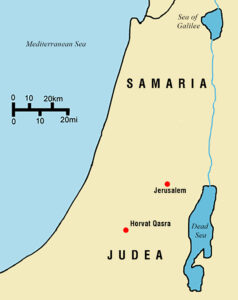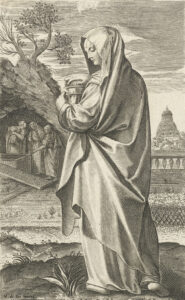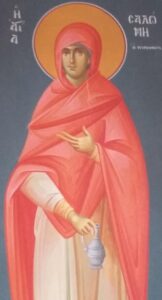By Dr. Don Bierle, FaithSearch President
Does this sound like the setup to an old joke? (“Who is buried in Grant’s tomb?”) Well, Salome is, I suppose! The question arises, who was she?

On a hilltop in the foothills of southern Judea, near the ancient road connecting the plains and foothills with Hebron, is Horvat Qasra with a cave chapel dedicated to Saint Salome. Horvat Qasra was a first century hilltop agricultural estate consisting of seven-and-a-half acres with a wealthy fortified residence and a separate tomb complex. It is about thirty-five miles south of Jerusalem.
By the middle of the second century AD the site was mostly forgotten until the Byzantine Christians in the fifth century converted the tomb complex into a cave chapel dedicated to a woman by the name of Salome. Inscriptions throughout the site appealing to her as “Holy Salome” and “Lady” clearly indicate she was revered as a saint.
Searching for Salome
Archaeologists and scholars have considered several “Salomes” as candidates for “Holy Salome.”

- The “dancing” daughter of Herodias who requested the head of John the Baptist at Herod Antipas’ birthday party (Mark 6:14-29). She hardly qualifies as a saint!
- A midwife of Mary identified in an apocryphal tale the Protoevangelium of James. Christians would hardly give “saint” status to a nonbiblical and nonhistorical person.
- Sixth century apocryphal writings (History of Joseph the Carpenter; Arabic Infancy Gospel) identify a couple of other “Salomes,” one a midwife and the other who supposedly accompanied Jesus’ family to Egypt. Neither has any historical validity.
The “Elephant” in the Room
It is difficult to comprehend why much text would be spilled in professional journals surveying history for “Salomes” who could possibly be in Salome’s tomb, when a significant Jewish disciple of Jesus by the name of Salome is recorded in the biblical Gospels. Besides her devoted service to Jesus during His ministry, she has a very significant identity. Consider the following parallel Gospel passages about women who were observing Jesus on the cross:
- “…among whom was Mary Magdalene, along with Mary the mother of James and Joseph, and the mother of the sons of Zebedee” (Matthew 27:56).
- “…and there were also some women looking on from afar, among whom were Mary Magdalene, and Mary the mother of James the Less and Joses, and Salome” (Mark 15:40).
- “…But there were standing by the cross of Jesus His mother, and His mother’s sister, Mary the wife of Clopas, and Mary Magdalene” (John 19:25).
A comparison of these three passages reveals that “the mother of the sons of Zebedee”; “Salome”; and “His mother’s sister” are the same person. Salome is the sister of Jesus’ mother Mary, and therefore His “aunt.” The sons of Zebedee, James and John, were then Jesus’ cousins. Incidentally, is that why Salome was emboldened to ask of Jesus a favor to have her sons (His cousins) rule on His left and right in His future kingdom? (cf. Matthew 20:20-21)
Salome: Respected or Venerated?
All Christian traditions, Protestant, Catholic, and Orthodox, agree that deep respect for the faith and actions of Salome is appropriate.
- She ministered to Jesus with her time and devotion (Mark 15:41).
- She supported His ministry with her private means (Luke 8:2-3).
- She was a witness of His crucifixion (Matthew 27:55-56).
- She was one of the spice-bearing women desiring to anoint the body of Jesus (Mark 16:1).
- She was one of the first to hear from the angel about Jesus’ resurrection (Mark 16:1, 5-7).

The unity regarding her identity ends there. In Catholicism and Orthodox Christianity, Salome is venerated as a saint. This means that she, along with many others, are seen as alive in Christ and able to pray for those on earth, seeking God’s mercy and blessings for them. Orthodox Christians pray with the saints, asking them to intercede to God on their behalf, not praying to them.
Protestant Christians generally oppose the veneration of saints because it is not supported in the Bible, believing that Scripture is the sole source of doctrine and practice. Secondly, the Bible teaches that there are only two mediators between man and God: Jesus Christ (1 Timothy 2:5) and the Holy Spirit (Romans 8:26-27). Christians are to pray directly to God, trust Him alone, and not rely on deceased intermediaries.
What of Christian Unity then?
Some aspects of Christianity are non-negotiable. The apostle Paul identified the “bullseye” of Christian faith:
According to the grace of God which was given to me, as a wise master builder I laid a foundation…for no man can lay a foundation other than the one which is laid, which is Jesus Christ (1 Corinthians 3:10-11).
Other biblical teachings are also crucial such as the apostle Paul’s insistent that salvation is by God’s grace through faith alone (Galatians 1:6-8; Ephesians 2:8-9). On some issues, like how to view Salome, Christians are still seeking to find common ground. Regarding the central tenant of Jesus Christ, to be a Christian you must agree that “…there is salvation in no one else; for there is no other name under heaven that has been given among men by which we must be saved” (Acts 4:12).
On that point the Protestants, Catholics, and Orthodox believers all agree – so would Salome!
Source: “The Cave of Salome – Tomb of Jesus’ Disciple?” Joan E. Taylor and Boaz Zissu. Biblical Archaeology Review, Spring 2024, pp. 34-41.



